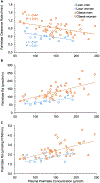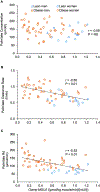Increased plasma fatty acid clearance, not fatty acid concentration, is associated with muscle insulin resistance in people with obesity
- PMID: 35577100
- PMCID: PMC10424797
- DOI: 10.1016/j.metabol.2022.155216
Increased plasma fatty acid clearance, not fatty acid concentration, is associated with muscle insulin resistance in people with obesity
Abstract
Background: Although it is well-accepted that increased plasma free fatty acid (FFA) concentration causes lipid overload and muscle insulin resistance in people with obesity, plasma FFA concentration poorly predicts insulin-resistant glucose metabolism. It has been proposed that hyperinsulinemia in people with obesity sufficiently inhibits adipose tissue triglyceride lipolysis to prevent FFA-induced insulin resistance. However, we hypothesized enhanced FFA clearance in people with obesity, compared with lean people, prevents a marked increase in plasma FFA even when FFA appearance is high.
Methods: We assessed FFA kinetics during basal conditions and during a hyperinsulinemic-euglycemic clamp procedure in 14 lean people and 46 people with obesity by using [13C]palmitate tracer infusion. Insulin-stimulated muscle glucose uptake rate was evaluated by dynamic PET-imaging of skeletal muscles after [18F]fluorodeoxyglucose injection.
Results: Plasma FFA clearance was accelerated in participants with obesity and correlated negatively with muscle insulin sensitivity without a difference between lean and obese participants. Furthermore, insulin infusion increased FFA clearance and the increase was greater in obese than lean participants.
Conclusions: Our findings suggest plasma FFA extraction efficiency, not just plasma FFA concentration, is an important determinant of the cellular fatty acid load and the stimulatory effect of insulin on FFA clearance counteracts some of its antilipolytic effect.
Trial registration: ClinicalTrials.gov NCT02994459 NCT03408613.
Keywords: Adipose tissue; Fatty acids; Insulin resistance; Obesity.
Copyright © 2022. Published by Elsevier Inc.
Conflict of interest statement
DECLARATION OF INTEREST
The authors report no conflicts of interest relevant to this article.
Figures



Similar articles
-
Relationship between adipose tissue lipolytic activity and skeletal muscle insulin resistance in nondiabetic women.J Clin Endocrinol Metab. 2012 Jul;97(7):E1219-23. doi: 10.1210/jc.2012-1035. Epub 2012 Apr 6. J Clin Endocrinol Metab. 2012. PMID: 22492868 Free PMC article. Clinical Trial.
-
Thiazolidinediones increase plasma-adipose tissue FFA exchange capacity and enhance insulin-mediated control of systemic FFA availability.Diabetes. 2001 May;50(5):1158-65. doi: 10.2337/diabetes.50.5.1158. Diabetes. 2001. PMID: 11334421
-
Plasma free fatty acids decrease insulin-stimulated skeletal muscle glucose uptake by suppressing glycolysis in conscious rats.Diabetes. 1996 Apr;45(4):446-53. doi: 10.2337/diab.45.4.446. Diabetes. 1996. PMID: 8603766
-
Free fatty acids, insulin resistance, and type 2 diabetes mellitus.Proc Assoc Am Physicians. 1999 May-Jun;111(3):241-8. doi: 10.1046/j.1525-1381.1999.99220.x. Proc Assoc Am Physicians. 1999. PMID: 10354364 Review.
-
Free fatty acids in obesity and type 2 diabetes: defining their role in the development of insulin resistance and beta-cell dysfunction.Eur J Clin Invest. 2002 Jun;32 Suppl 3:14-23. doi: 10.1046/j.1365-2362.32.s3.3.x. Eur J Clin Invest. 2002. PMID: 12028371 Review.
Cited by
-
Cold acclimation with shivering improves metabolic health in adults with overweight or obesity.Nat Metab. 2024 Dec;6(12):2246-2253. doi: 10.1038/s42255-024-01172-y. Epub 2024 Dec 6. Nat Metab. 2024. PMID: 39643644 Clinical Trial.
-
Insulin Hypersecretion as Promoter of Body Fat Gain and Hyperglycemia.Diabetes. 2024 Jun 1;73(6):837-843. doi: 10.2337/dbi23-0035. Diabetes. 2024. PMID: 38768368 Free PMC article. No abstract available.
-
New improved radiometabolite analysis method for [18F]FTHA from human plasma: a test-retest study with postprandial and fasting state.EJNMMI Res. 2024 Jun 13;14(1):53. doi: 10.1186/s13550-024-01114-5. EJNMMI Res. 2024. PMID: 38869780 Free PMC article.
-
Impaired Suppression of Plasma Lipid Extraction and Its Partitioning Away From Muscle by Insulin in Humans With Obesity.J Clin Endocrinol Metab. 2025 May 19;110(6):1647-1656. doi: 10.1210/clinem/dgae727. J Clin Endocrinol Metab. 2025. PMID: 39401337 Clinical Trial.
-
Potential Benefits of Antioxidant Phytochemicals in Type 2 Diabetes.Molecules. 2023 Oct 21;28(20):7209. doi: 10.3390/molecules28207209. Molecules. 2023. PMID: 37894687 Free PMC article. Review.
References
-
- Solis-Herrera C, Triplitt C, Cersosimo E, DeFronzo RA. Pathogenesis of Type 2 Diabetes Mellitus. In: Feingold KR, Anawalt B, Boyce A, Chrousos G, de Herder WW, Dhatariya K, et al., editors. Endotext South Dartmouth (MA): MDText.com, Inc.; 2000.
-
- Johnston LW, Harris SB, Retnakaran R, Giacca A, Liu Z, Bazinet RP, et al. Association of NEFA composition with insulin sensitivity and beta cell function in the Prospective Metabolism and Islet Cell Evaluation (PROMISE) cohort. Diabetologia 2018;61:821–30. - PubMed
Publication types
MeSH terms
Substances
Associated data
Grants and funding
LinkOut - more resources
Full Text Sources
Medical

